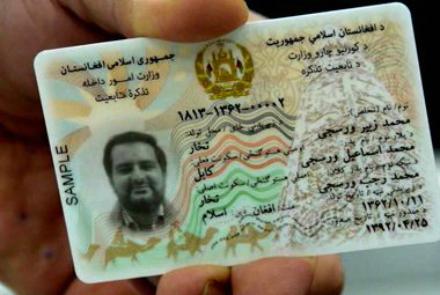On top of almost insurmountable security and economic obstacles, Afghans now face an identity crisis that threatens their national unity and could pave the way for a complete Balkanization of this fragile nation.
The division erupted after the government decided to convert its national ID cards from paper to an electronic version. This sparked anger, shouting and hot debate among multi-ethnic Afghans in public, private and official arenas.
The new electronic version would be harder to duplicate or forge than the paper Tazkera cards and would contain each citizen’s nationality, tribe and religious affiliation.
Afghans grew bitterly divided over this, and it has turned into a highly emotional and contentious issue. In parliament, discussions of the pros and cons have unraveled into shouting matches and name-calling, with opposing sides accusing each other of unpatriotic acts and treason.
Proponents argue that the nation should become united under the term “Afghan,” and nationalities with tribal and religious affiliations should be on everyone’s e-Tazkera card. Opponents, mostly non-Pashtuns, oppose this on the grounds that the word “Afghan” does not apply to them. One member of parliament from the north called the government decision discriminatory, divisive and archaic.
How have Afghans come to this point?
Over two centuries ago, Ahmad Khan Abdali, a Pashtun from Kandahar province, named his new kingdom Afghanistan, meaning “land of the Afghans.” Although the term “Afghan” originally referred to Pashtuns, other ethnic groups such as Tajik, Uzbek and Hazara eventually adopted the name “Afghan” as their national identity.
I recall that in elementary school, our textbooks taught that anyone who is from Afghanistan is an Afghan, and it was not a major issue.
Originally, Afghanistan was merely a city-state, with the rest of the current country comprised of semi-independent fiefdoms: Tajik and Uzbek in the north, Hazara in the central zone and Pashtuns in the east and south. Those provinces were self-sufficient agrarian economies with few ties or commerce with each other due to a lack of roads, bridges and infrastructure.
To some degree, a lack of commercial exchange between these regions persisted, with various regions acting as “countries within a country,” maintaining a loose connection to the central government in Kabul. Central rulers colluded with tribes, landlords and religious figures to maintain a status quo, with relative security and harmony among the various ethnic populations.
But after the collapse of the Afghan monarchy and the communist takeover in the late 1970’s, Afghanistan went through dramatic changes. Most important was the breakup of the semi-feudal order. Landlords and tribal and religious leaders lost their influence, and a new elite from the “have-nots” replaced the bureaucrats. They forged alliances and became the new governors, ambassadors and members of parliament. Multi-ethnic Afghans soon became polarized, each group fighting for a share of power and social justice.
Today, many are searching for an identity. Are they Afghans? Should they choose to be something else? Citizens are divided, and so is the Afghan Unity Government.
Afghan president Ashraf Ghani, who was to be the first to get his e-Tazkera, still hasn’t received it, reportedly because of opposition not only from his CEO Abdullah Abullah, but also from other members of his government, including the powerful governor of Maza-e-Sharif, Atta Mohammad Noor, a former Mujahedeen commander who refused to step down from his position despite being fired by President Ghani.
Afghan leaders have failed to find a solution for the e-Tazkera controversy, which could nudge the country toward Balkanization.
Political scientist Rupert Emerson defined national identity as "a body of people who feel that they are a nation." Social psychologist Henri Tajfel, who formulated social identity theory together with John Turner, suggests that the conceptualization of national identity includes both self-categorization and affect. The affect part refers to the emotion a person has with this identification, such as a sense of belonging, or emotional attachment toward one's nation.
Is there a solution? Yes. Afghanistan’s identity crisis is a byproduct of citizen polarization. Afghanistan is not completely out of the feudal and tribal structure. The country is making progress on human rights and social equality, but it has a long way to go. We should not expect too much from a country with few resources and a brief history of democracy.
To solve the national identity crisis, both sides must compromise if they want to survive as one nation. Each individual citizen should have the right to choose whether their nationality, religion or tribe will appear on their identity card. I believe this is a win for both sides.
If the Afghan rulers fail to allow this right, the divisions will remain and could result in violent in-fighting. Afghanistan has many more important challenges to face than fighting over whether their ID cards show their particular tribe and religion.

